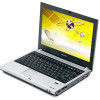Toshiba Satellite U200-ST2092 User Manual - Page 216
Backing up your data to CDs with the Windows, operating system, My Documents, Open writable
 |
View all Toshiba Satellite U200-ST2092 manuals
Add to My Manuals
Save this manual to your list of manuals |
Page 216 highlights
216 If Something Goes Wrong Develop good computing habits NOTE This list may contain Restore Points that you did not create. Restore Points labeled System Checkpoint were automatically created by the Windows operating system. Other Restore Points may have been created automatically by applications when they were installed. 6 Select the desired Restore Point from the list, and then click Next. 7 Your Windows configuration will now be restored to the state it was in when the chosen Restore Point was created. Backing up your data to CDs with the Windows operating system For most of us, by far the most valuable component of our computer system is the data we have created with it, and stored on its hard disk drive. Since problems with either hardware or software can make the data inaccessible or even destroy it, the next most valuable component of your computer system may be a recent backup of your data. Fortunately, the Windows operating system offers a convenient way to back up your important data files to CDs, a relatively high-capacity storage media. No additional software is required. Most of the CD and DVD drives built into recent Toshiba portable computer models can write to (or 'burn') as well as read from CDs. External CD and DVD writers are also widely available. Follow these steps to back up files in the My Documents folder to one or more CDs: 1 Put a blank CD-R (CD-recordable) disc into the computer's CD or DVD drive. 2 A menu of options will appear. Select Open writable CD folder using Windows Explorer, and click OK.















